SUBFAMILY FORMICINAE - Genus Plagiolepis
| The Ants of
Africa SUBFAMILY FORMICINAE - Genus Plagiolepis |
|
| Contents - Formicinae - FORMICINAE Introduction |
Diagnostic Features - Antennae 11-segmented. Eyes well developed and situated in the middle of the sides of the head. Ocelli usually absent. Mandibles with five teeth, clypeus large and projecting over the basal borders of mandibles. Alitrunk short, weakly constricted between pronotum and propodeum. Propodeum unarmed. Petiole a reduced scale, inclined forwards and may be overhung by the first gastral segment, never armed or emarginate. Acidopore borne on a conical projection, surrounded by a fringe of hairs. Monomorphic or polymorphic.
Mayr's (1861) genus description is at ![]() .
.
The Genus has over 50 recognised members throughout the Old World tropics and subtropics, plus the Mediterranean area and Australasia. Southern and Eastern Africa have around fifteen species and, so, it is perhaps surprising that West Africa and the Congo Basin have only two recognised species, plus a few so far undefined forms. It may well be the case, however, that the Genus members are primarily associated with arid or semi-arid climates.
Santschi (1914e: 36) erected the subgenus Anacantholepis for Plagiolepis in which the metanotum is very raised and distinctly separated from a short convex propodeum (he regarded it as an intermediate transition to the genus Lepisiota (as Acantholepis).
Thus, Arnold (1922) used -
Anacantholepis Santschi - metanotum very prominent, separated
from the short and convex propodeum by a deep suture (metanotal
groove); propodeum higher than the metanotum; rarely polymorphic.
Plagiolepis Mayr - metanotum not prominent; metanotal-propodeal
suture (metanotal groove) usually feeble; propodeum oblique, not higher
or not much higher than the metanotum; small species, not polymorphic.
He also provided a (rather confusing) key, including the now separate
genus Anoplolepis: the part covering Plagiolepis is at ![]() .
.
Santschi (1926a) clarified and restated his definitions of the Genus
and the subgenera Plagiolepis and Anacantholepis. These
are at ![]() .
.
Bolton (1995) had "Anacantholepis provisional junior synonym of Plagiolepis; Brown, 1973b: 178 (unconfirmed)". This was asserted again by Bolton (2003: 268), with the added remark that he found it impossible to resolve whether Plagiolepis and Lepisiota - "represent a single genus" or "the mass can be resolved into more than (that sic) two genera".
Bolton (2003), however, referred to Santschi's (1914c) definiton of Anacantholepis as "those species in which the metanotum, when viewed in profile, was more prominent dorsally, and the propodeum more strongly convex than was 'normal' in the genus". Bolton continued - "Both these features are marked only in the South African type species, P. (A.) decora, being less well developed elsewhere and intermediate".
Simple examination of the descriptions and illustrations (see the key below) reveals that the Santschi separation is very clear for several species and the subgenus appears to fully merit its status. Accordingly, I have returned to the situation prior to statements of Brown and Bolton, neither of whom appear to have given any supporting evidence or to have undertaken a review of the described species.
The Mediterranean/North African species Plagiolepis (P.) pallescens, Plagiolepis (P.) maura and Plagiolepis (P.) schmitzii can be seen on the links.
Provisional key to workers of sub-Saharan members the Genus Plagiolepis (based primarily on historic descriptions)
| ¤ | Queen only - photographs on species page - genus status uncertain |
South Africa - capensis |
| 1 |  Metanotum small,
no longer than half the length of the
mesonotum and not raised into a distinct welt; propodeum generally low
and obliquely rounded Metanotum small,
no longer than half the length of the
mesonotum and not raised into a distinct welt; propodeum generally low
and obliquely rounded |
subgenus Plagiolepis - 9 |
| -- | 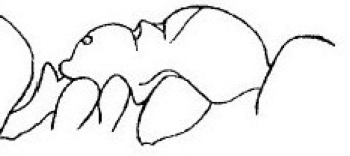 Metanotum
very prominent, mostly raised into a distinct welt; most with a domed
profile to the propodeum Metanotum
very prominent, mostly raised into a distinct welt; most with a domed
profile to the propodeum |
subgenus Anacantholepis - 2 |
| - | Subgenus Anacantholepis | - |
| 2 | 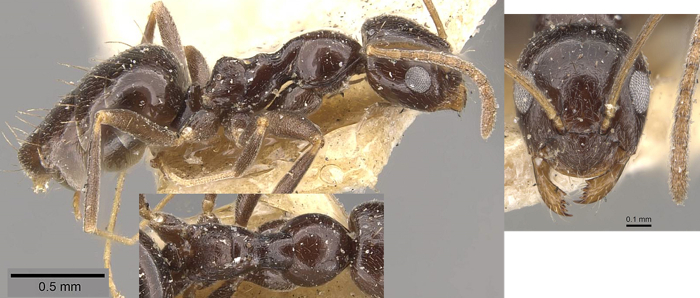 Scape surpassing occiput by
half to four-fifths of own length; TL 2.5-2.7 mm; head
oval-rectangular, metanotal groove reduced; colour dark castaneous
brown, alitrunk black, legs brownish Scape surpassing occiput by
half to four-fifths of own length; TL 2.5-2.7 mm; head
oval-rectangular, metanotal groove reduced; colour dark castaneous
brown, alitrunk black, legs brownish |
South Africa - deweti |
| -- | Scapes surpassing occiput by no more than one-quarter of own length | 3 |
| 3 | Scapes surpassing occiput by about one-quarter of own length | 4 |
| -- | Scapes surpassing occiput but by less than one-quarter of own length | 6 |
| 4 |  TL major worker (replete,
honey-storage form) 1.7-4.0 mm; minor worker TL 1.7-2.0 mm; head
elongate HL about one-quarter > HW, rounded and rectangular; colour
entirely black, appendages dull brown to reddish TL major worker (replete,
honey-storage form) 1.7-4.0 mm; minor worker TL 1.7-2.0 mm; head
elongate HL about one-quarter > HW, rounded and rectangular; colour
entirely black, appendages dull brown to reddish |
South Africa - jouberti |
| -- | Monomorphic and not wholly black | 5 |
| 5 |  TL
1.5-1.6 mm; HL distinctly > HW, sides arcuate, occiput convex with
lateral angles rounded; eyes set around mid-point of head about
one-quarter of HL; propodeum a strongly convex and smooth curve;
overall quite shiny; alitrunk and mandibles testaceous red, head and
gaster black, appendages yellowish TL
1.5-1.6 mm; HL distinctly > HW, sides arcuate, occiput convex with
lateral angles rounded; eyes set around mid-point of head about
one-quarter of HL; propodeum a strongly convex and smooth curve;
overall quite shiny; alitrunk and mandibles testaceous red, head and
gaster black, appendages yellowish |
. |
| . | 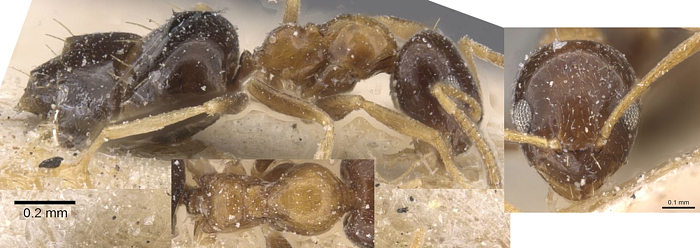 |
South Africa - polita |
| -- | 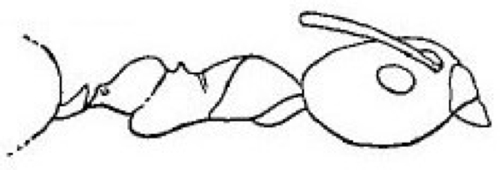 TL
2.2-2.4 mm; head and gaster with sparse microscopic yellowish
pubescence; smooth and shiny; colour reddish-yellow, apical margins and
sides of tergites infuscated TL
2.2-2.4 mm; head and gaster with sparse microscopic yellowish
pubescence; smooth and shiny; colour reddish-yellow, apical margins and
sides of tergites infuscated |
. |
| . |  |
Zimbabwe & Tanzania - chirendensis |
| 6 | Scapes distinctly surpassing occiput | 7 |
| -- | Scapes scarcely surpassing occiput | 8 |
| 7 | 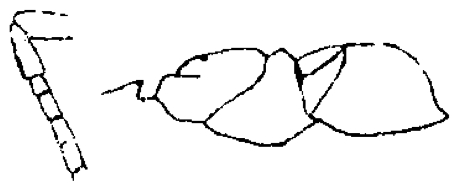 Scape
surpassing occiput by about one-seventh of its own length; TL 1.6 mm;
HL slightly < HW; eyes large, ocelli distinct; propodeum notably
flattened; petiole scale low and
highly inclined; colour yellow-brown, head darker Scape
surpassing occiput by about one-seventh of its own length; TL 1.6 mm;
HL slightly < HW; eyes large, ocelli distinct; propodeum notably
flattened; petiole scale low and
highly inclined; colour yellow-brown, head darker |
. |
| . | 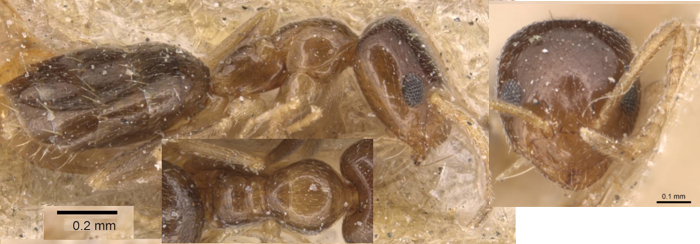 |
Lesotho - simoni |
| -- | 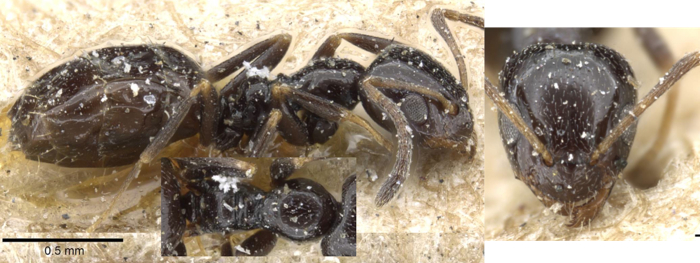 TL 2.0 mm; head truncate behind, sides arcuate;
mandibles narrow and 5-dentate; propodeum domed (gibbous) very shiny;
colour piceous, appendages
rufescent TL 2.0 mm; head truncate behind, sides arcuate;
mandibles narrow and 5-dentate; propodeum domed (gibbous) very shiny;
colour piceous, appendages
rufescent |
South Africa - fuscula |
| -- | 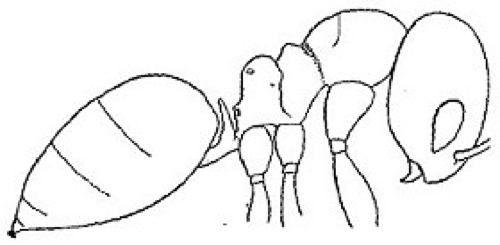 TL
1.4-1.5 mm; eyes distinctively elongate oval, set in anterior third of
head and larger than their
distance from the anterior margin of the head; antennae surpass occiput
by about one-sixth of own length; very shiny, black, appendages yellow
brown or lighter TL
1.4-1.5 mm; eyes distinctively elongate oval, set in anterior third of
head and larger than their
distance from the anterior margin of the head; antennae surpass occiput
by about one-sixth of own length; very shiny, black, appendages yellow
brown or lighter |
. |
| . |  |
Kenya & Tanzania - pictipes |
| -- | 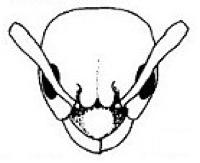 TL
1.4-1.5 mm; clypeus produced anteriorly and partly covering mandibles;
relatively large eyes; scape distinctly swollen apically; alitrunk
profile medially flat, metanotal groove distinct, bordered posteriorly
by a spiracular tubercle; shiny and smooth; fine sparse pubescence most
abundant on head, few erect hairs most on alitrunk; colour medium
brown, appendages yellowish-brown (close to mediorufa) TL
1.4-1.5 mm; clypeus produced anteriorly and partly covering mandibles;
relatively large eyes; scape distinctly swollen apically; alitrunk
profile medially flat, metanotal groove distinct, bordered posteriorly
by a spiracular tubercle; shiny and smooth; fine sparse pubescence most
abundant on head, few erect hairs most on alitrunk; colour medium
brown, appendages yellowish-brown (close to mediorufa) |
. |
| . |  |
Sudan & Cameroun (Congo Basin) - sudanica |
| 8 | 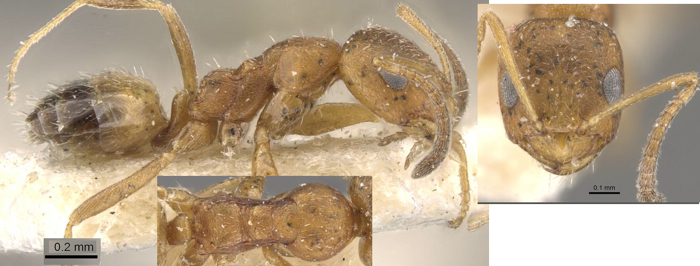 TL 1.5-1.6 mm; propodeum with
rectangular dorsum, separated from
declivity by a fairly sharp margin, with a sharp corner at each side;
head and alitrunk dull, very finely and closely punctate; colour head
rust brown, alitrunk rust, gaster black (dark brown), appendages
yellowish; image is od vanderkelleni
tricolor) TL 1.5-1.6 mm; propodeum with
rectangular dorsum, separated from
declivity by a fairly sharp margin, with a sharp corner at each side;
head and alitrunk dull, very finely and closely punctate; colour head
rust brown, alitrunk rust, gaster black (dark brown), appendages
yellowish; image is od vanderkelleni
tricolor) |
Southern Africa - vanderkelleni |
| -- | 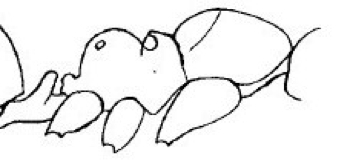 TL
1.6-1.8 mm; HL about one-fifth > HW, head subrectangular with
corners widely rounded, eyes placed well forward of mid-point of head;
smooth and shiny; almost glabrous; colour bright ochreous or amber
yellow, head often with a reddish tinge, genae, apex of funiculus,
petiole peduncle and spots on sides of first two gaster segments brown TL
1.6-1.8 mm; HL about one-fifth > HW, head subrectangular with
corners widely rounded, eyes placed well forward of mid-point of head;
smooth and shiny; almost glabrous; colour bright ochreous or amber
yellow, head often with a reddish tinge, genae, apex of funiculus,
petiole peduncle and spots on sides of first two gaster segments brown |
. |
| . | 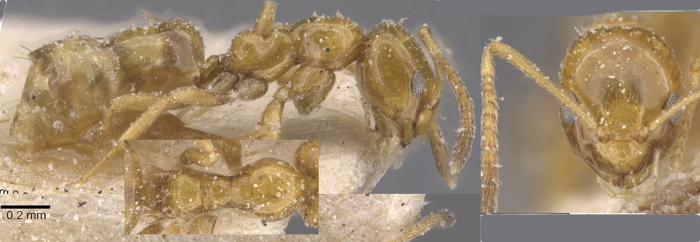 |
South Africa - decora |
| subgenus Plagiolepis | - | |
| 9 | 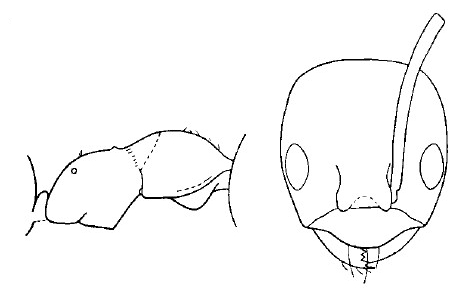 Alitrunk with no
obvious pro-mesonotal suture; head
usually with flat occipital margin Alitrunk with no
obvious pro-mesonotal suture; head
usually with flat occipital margin |
10 |
| -- |  Alitrunk with
distinct pro-mesonotal suture; head usually
with concave occipital margin Alitrunk with
distinct pro-mesonotal suture; head usually
with concave occipital margin |
11 |
| 10 |  TL
1.3-1.7 mm; HL = HW, sides moderately convex, narrower in front,
occiput shallowly concave; metanotal suture feeble; colour dark orange
or reddish ochre, apical two-thirds of funiculus and basal half of
femora fuscous, gaster with apical brown band on first three segments TL
1.3-1.7 mm; HL = HW, sides moderately convex, narrower in front,
occiput shallowly concave; metanotal suture feeble; colour dark orange
or reddish ochre, apical two-thirds of funiculus and basal half of
femora fuscous, gaster with apical brown band on first three segments |
. |
| . | 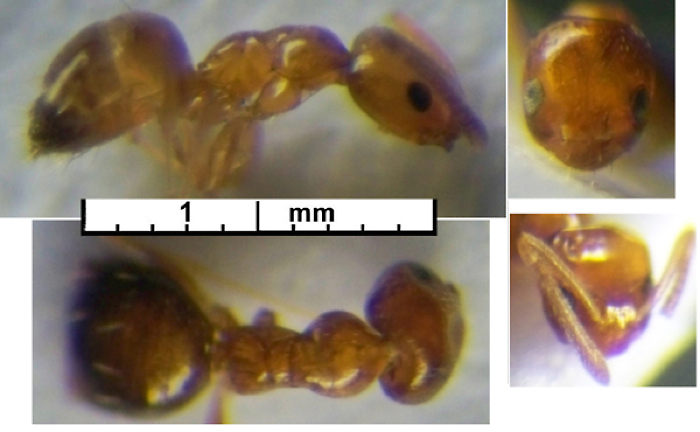 |
Pan-African - brunni |
| -- |  TL
1.25-1.33 mm; scape attaining or just surpassing occiput; promesonotum
more distinctly convex; posterior mesonotum and metanotum continuous;
colour clear testaceous, appendages paler, tips of funiculi sometimes
brownish TL
1.25-1.33 mm; scape attaining or just surpassing occiput; promesonotum
more distinctly convex; posterior mesonotum and metanotum continuous;
colour clear testaceous, appendages paler, tips of funiculi sometimes
brownish |
Pan-African & tramp - alluaudi |
| -- | 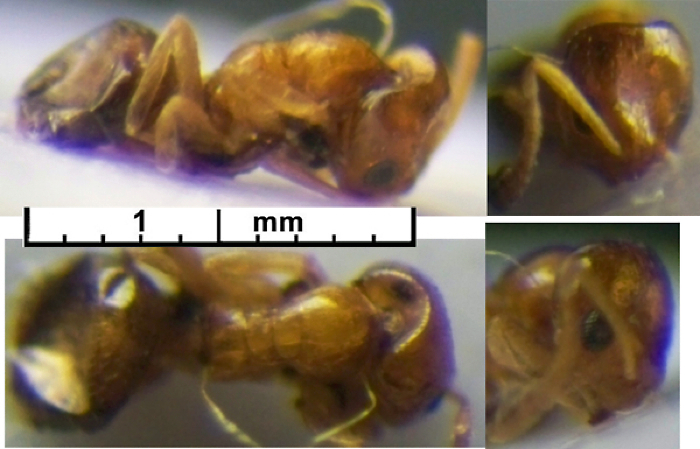 Insufficient details; TL 1.2
mm; comparison with exigua;
colour brown-black
with alitrunk red-brown; with long low petiole; scape surpassing
occiput by about its own width; slightly duller and with more obvious
sparse pubescence Insufficient details; TL 1.2
mm; comparison with exigua;
colour brown-black
with alitrunk red-brown; with long low petiole; scape surpassing
occiput by about its own width; slightly duller and with more obvious
sparse pubescence |
Ethiopia - abyssinica |
| . | Alitrunk with distinct pro-mesonotal suture; head usually with concave occipital margin | - |
| 11 | 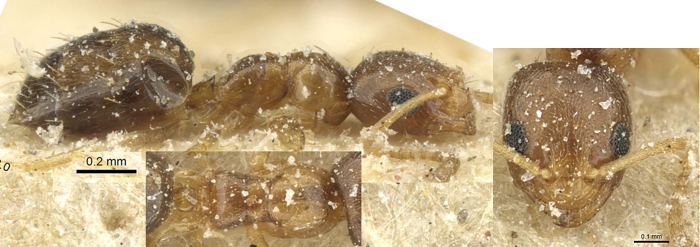 Scapes clearly surpassing
occiput by about one-quarter of own length; TL 1.6-1.9 mm; clypeus with
sharp median carina posteriorly; smooth and shiny; head with quite
dense pubescence; colour rust-red, underside of head smoky, gaster
brownish Scapes clearly surpassing
occiput by about one-quarter of own length; TL 1.6-1.9 mm; clypeus with
sharp median carina posteriorly; smooth and shiny; head with quite
dense pubescence; colour rust-red, underside of head smoky, gaster
brownish |
Zambia - livingstonei |
| -- | Scapes attaining but hardly surpassing occiput if at all | 12 |
| 12 | TL at least 1.9 mm; scape clearly attaining or slightly surpassing occiput | 13 |
| -- | TL < 1.5 mm | 15 |
| 13 |  TL
2.2 mm; quite slender, ocelli distinct; metanotum about two-thirds as
long as mesonotum; entirely smooth and shiny; colour head and thorax
ochreous brown, gaster brown TL
2.2 mm; quite slender, ocelli distinct; metanotum about two-thirds as
long as mesonotum; entirely smooth and shiny; colour head and thorax
ochreous brown, gaster brown |
. |
| . | 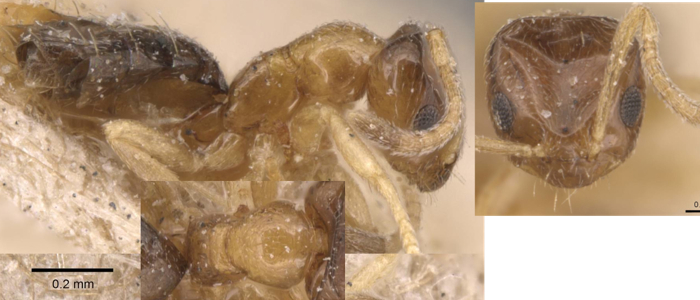 |
South Africa - intermedia |
| -- | TL no more than 2.0 mm | 14 |
| 14 | 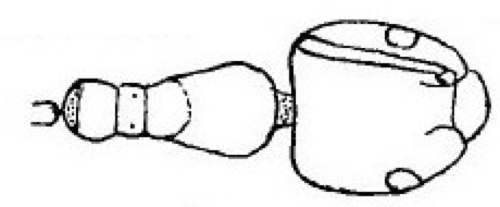 TL
1.9 mm; smooth and shiny; colour head brownish black, alitrunk reddish
ochreous, gaster black TL
1.9 mm; smooth and shiny; colour head brownish black, alitrunk reddish
ochreous, gaster black |
Lesotho - montivaga |
| -- |  TL 1.9-2.0 mm; scape surpassing occiput by about
its own width; very fine pubescence and only two or three erect hairs
on the gaster; smooth and shiny; colour chestnut brown or redder,
gaster and posterior of head darker TL 1.9-2.0 mm; scape surpassing occiput by about
its own width; very fine pubescence and only two or three erect hairs
on the gaster; smooth and shiny; colour chestnut brown or redder,
gaster and posterior of head darker |
South Africa - funicularis |
| 15 | Occiput medially impressed | 16 |
| -- | Occiput convex not medially impressed | 17 |
| 16 |  TL
1.3-1.2 mm; smooth and very shiny; colour dark brown, funiculus dusky
ochreous TL
1.3-1.2 mm; smooth and very shiny; colour dark brown, funiculus dusky
ochreous |
South Africa & Mediterranean - pygmaea |
| -- |  TL 1.3-1.5 mm; colour as pygmaea, except
funiculus mostly dark brown; notably longer metanotum, almost as long
as mesonotum, metanotal groove very shallow TL 1.3-1.5 mm; colour as pygmaea, except
funiculus mostly dark brown; notably longer metanotum, almost as long
as mesonotum, metanotal groove very shallow |
South Africa - puncta |
| 17 |  TL 1.1-1.4 mm;
different from pygmaea in having a
narrower head, which is not impressed, especially convex behind, with
convex sides; characteristic colour is head and gaster brown; thorax of
a more or less reddish yellow; coxae and funiculi brown; rest of
appendages yellowish TL 1.1-1.4 mm;
different from pygmaea in having a
narrower head, which is not impressed, especially convex behind, with
convex sides; characteristic colour is head and gaster brown; thorax of
a more or less reddish yellow; coxae and funiculi brown; rest of
appendages yellowish |
Zaïre - mediorufa |
| -- | 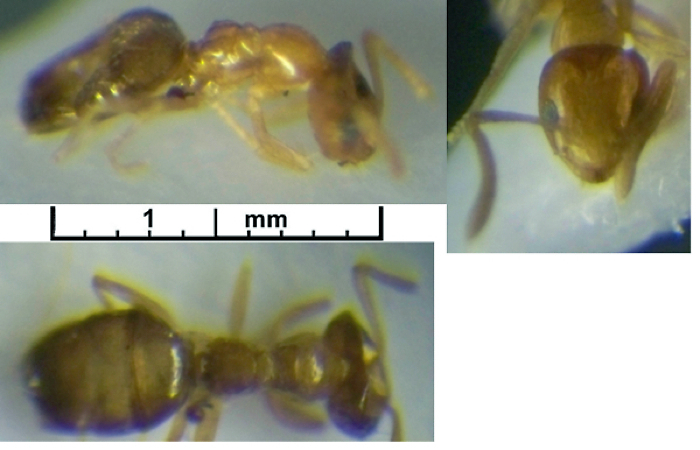 TL ca 1.5 mm; head in full face view ovoid with weakly
convex occiput TL ca 1.5 mm; head in full face view ovoid with weakly
convex occiput |
Sudan and tramp - Plagiolepis exigua |
| Subfamily Formicinae |
© 2007, 2010, 2011, 2013, 2014 - Brian Taylor CBiol
FSB FRES 11, Grazingfield, Wilford, Nottingham, NG11 7FN, U.K. |
href="plagiolepis.htm"